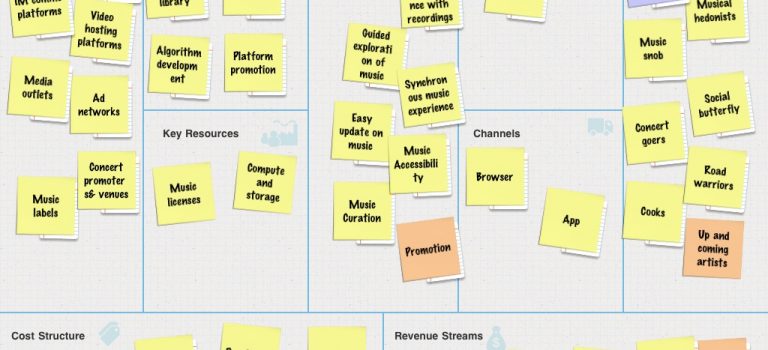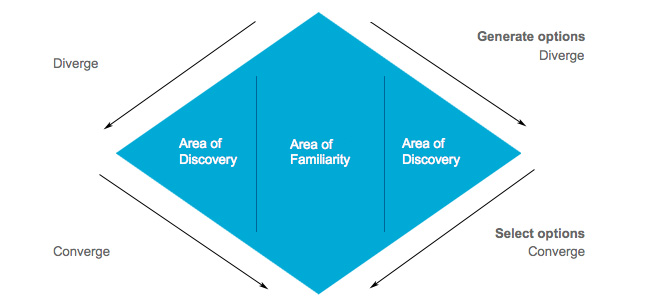Recently, I spoke to Deloitte‘s Innovation Concepts Manager Marc Maes and Innovation Consultant Klaas Langeveld about their idea of managing innovation and idea generation within companies. They explained me about their Fast Track strategy and their home-made Innovation Maturity Model. The model intrigued me because of its fairly complete coverage of innovation-related issues and its slim simplicity. It triggered me to grab some literature to find prove of this model. My rationality: if it looks simple and complete, it must be good. And if it’s really good, it must be (partly) supported by earlier findings.
Deloitte’s Innovation Maturity Model: a short explanation.
Below, you’ll see the adopted version of Deloitte’s Innovation Maturity Model. The goal of the model is to “score” companies performances on innovation in the model. As Marc and Klaas said, probably in slightly other words, the line should be straight and preferably as high up as possible. Take a look for yourself:

So in the basis the model contains two axes, both unnamed. I’ll try to figure out correct names for them later on. On the vertical axe we’re basicly seeing four forms of doing business. On the horizontal axe we’re seeing management topics, three of which are combined into one: the innovation process. The result of the model would look something like this (I tried to complete them for [edit: anonymized on request], two companies I know fairly well):


Why is it good?
Now, it is time to look into some literature and give the two axes name plates. First of all, the vertical axe. The four aspect seem to correlate on “innovation effectiveness”. In innovation literature, when researching the effectiveness of innovation, scholars are often referencing to Organizational Development. Basically, the four above-mentioned steps have a lot in common with Greiner’s model of organizational growth (Greiner, 1972), which still is the most valued model about organization growth. Another perspective would be Rothwell‘s generations of innovation, who looks into adopted innovation models over time and shows the increasing professionalization of innovation management literature. The first three aspects are based on Greiner’s work, the “Network”-factor in Deloitte’s model is more or less based upon Rothwell’s work. Moreover, another traditional model organizational development – and later oftenly used to explain cultural differences – is Quinn & Cameron‘s model for Organizational Growth.


So, to be scientifically correct, I would suggest to use “organizational development” as the dimension of the vertical axis. And, if we would like to stick to just four aspects, then use:
- Adhocracy-oriented organization
- Interal-oriented organization
- Hierarchy-oriented organization
- Market-0riented organization
The second axis looks like two groups of aspects that are of interest for innovation managers. But why these? I’m seeing two different groups of aspects:
- Change management issues: what to do when you want your organization to change (develop)?
- Innovation process: how to manage your innovation process better?
For the first item, I would suggest to use one of the widely adopted change management models. For instance, the six logical levels interpretated from organizational perspective:
- Mission: is innovation part of your mission statement? Why (not)?
- Identity: is innovation part of your identity?
- Values: is innovation part of your key values? Is it part of your companies’ culture? How do you manage this?
- Knowledge: is your company competent on innovation? Do you include innovation in HRM?
- Behaviour: see next.
For the second item, which is all about behaviour, Deloitte has suggested three steps that make up the process of innovation. Many scholars have looked into these processes. I’ve gathered some of them:
| (Gopalakrishnan en Damanpour 1997) |
(Adams e.a. 2006) |
(Goffin en Pfeiffer 1999) |
(Verhaeghe en Kfir 2002) |
(Rothwell 1992) |
|
Inputs |
|
|
|
| Idea Generation |
Knowledge management |
Creativity |
Idea Generation |
Idea Generation |
| Project Definition |
Human Resources |
Technology Acquisition |
| Problem Solving |
Strategy |
Innovation Strategy |
Networking |
| Design and development |
Project management |
Portfolio Management |
Development |
Developing,
prototyping & manufacturing |
| Marketing and commercialization |
Commercialization |
Project management |
Commercialization |
Marketing &
Sales |
What we see is that there is no standard for the innovation process. But most of the literature suggests at least three items to be part of every innovation process:
- Idea Generation
- Concept Development
- Commercialisation
Those items are indeed very coherent with Deloitte’s model for innovation. To my opinion, “knowledge management” should be an integrated part of the innovation process. And then I mean “external knowledge management”, or, if you wish, market research or crowdsourcing. It should be step 0.
Conclusion: a practical model for innovation
All in all, Deloitte’s model would suffice for practical implementation and for companies looking for a way to place their own activities into perspective. Although it needs scientific perfectioning, it is very usable and friendly. What do you think? How is your company performing on the above-mentioned aspects?
Note: Deloitte did not instruct or reward me in any way for writing this article. Above-mentioned perspective is my personal reflection of their model. In fact, we are not only friends, we are also competitors, but that doesn’t mean I could not be interested in their perspective on innovation 😉






 Recent decades have been the years of outsourcing. Not only did companies outsource traditional cheap production towards more interesting markets, companies also outsourced most of their ICT and knowledge-based services towards cheaper countries. During recent years, many organisation have also outsourced their innovation departments and knowledge-intensive research and development branches towards countries in the Far East and Brazil. No longer does the Europe have the competitive advantage of being an innovative leader.
Recent decades have been the years of outsourcing. Not only did companies outsource traditional cheap production towards more interesting markets, companies also outsourced most of their ICT and knowledge-based services towards cheaper countries. During recent years, many organisation have also outsourced their innovation departments and knowledge-intensive research and development branches towards countries in the Far East and Brazil. No longer does the Europe have the competitive advantage of being an innovative leader.
 Last week the Global Innovation Barometer (GE) has been launched. The barometer provides results from (the most important) economies around the world . For instance, in the Dutch Report they conclude: “Innovation is a strategic priority for Dutch Businesses”, with almost 91% of the respondents mentioning it. Moreover, the report mentions the following indicators as most important for innovation:
Last week the Global Innovation Barometer (GE) has been launched. The barometer provides results from (the most important) economies around the world . For instance, in the Dutch Report they conclude: “Innovation is a strategic priority for Dutch Businesses”, with almost 91% of the respondents mentioning it. Moreover, the report mentions the following indicators as most important for innovation:

















